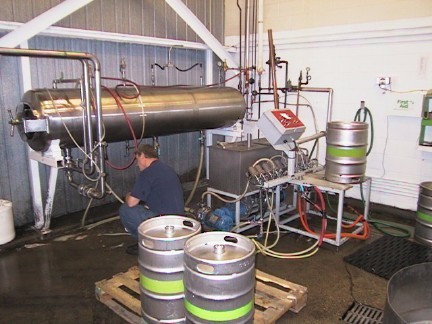
There are many types of kegs, and we presently use the Sankey Keg system. The keg is made of stainless steel because of its high resistance to abrasion, acid and alkali cleaning solutions, and its light weight. With parallel sides and a drum shape, as opposed to the rounded forms of older style kegs, the Sankey keg is well suited to automatic cleaning and filling, in addition to being physically more stable, either individually, or in a multiple stack.
In the keg racking area stands a processor controlled, two cycle racking machine. During the first cycle, before filling, the stainless steel kegs are scrupulously cleaned. The keg is placed in an inverted position, drained of dregs, washed and sterilised with hot caustic, then rinsed and pressurised with carbon dioxide. Particular attention is paid to the condition of the keg fittings. While the machine automatically drains, washes, rinses and pressurises the keg with carbon dioxide through one set of hoses, the operator will scrub the exterior of the keg.
The beer itself is run into a cylindrical tank located near the keg filling station. In the second cycle, the keg is righted, hoses exchanged, and lastly the beer flows by gravity and pressure into the prepressurised keg until full. Excess carbon dioxide pressure is bled off through a relief valve. The filling tap of the racking machine is then removed.
After filling, the kegs are transferred to a pallet in the racking area, with a full pallet being transferred to a cold storage area kept at a temperature of 2°C (36°F) to await shipment.
In our brewery, there is only a slight difference between draught and bottled beer. Draught beer is carbonated slightly lower than packaged beer, the reasons being the foaming problem encountered when filling the keg and consumer preference. The second difference is the fact that packaged beer is pasteurised. Draught beer is produced for quick sale, the draught beer being consumed in a matter of a few days after kegging. The packaged product may not be consumed for long periods of time, being subjected to fluctuating conditions, especially temperature extremes which could cause multiplication of any contaminating micro-organisms which may be present. This condition would produce drastic and undesirable flavour changes caused by the byproducts produced during microbiological metabolism.
The reason for pasteurisation of the packaged product is obvious. However, there is one further major consideration to remember. Pasteurisation in beer should more correctly be termed sterilisation. In the pasteurisation of milk, the primary object is to free the milk from pathogenic bacteria, the most important being mycobacterium tuberculosis, the microorganism causing tuberculosis. But, the temperature used does not kill all the microorganisms present. The presence of alcohol in beer, the relatively low pH, and the pressure arising in the bottle or can during pasteurisation, makes it possible to pasteurise beer at lower temperatures. Generally, 60°C (140°F) for twenty minutes will suffice to ensure a complete kill of all micro-organisms present, making the product sterile.